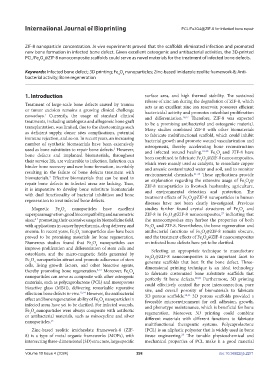Page 306 - IJB-10-4
P. 306
International Journal of Bioprinting PCL/Fe3O4@ZIF-8 for infected bone repair
ZIF-8 nanoparticle concentration. In vivo experiments proved that the scaffolds eliminated infection and promoted
new bone formation in infected bone defect. Given excellent osteogenic and antibacterial activities, the 3D-printed
PCL/Fe O @ZIF-8 nanocomposite scaffolds could serve as novel materials for the treatment of infected bone defects.
3 4
Keywords: Infected bone defect; 3D printing; Fe O nanoparticles; Zinc-based imidazole zeolite framework-8; Anti-
4
3
bacterial activity; Bone regeneration
1. Introduction surface area, and high thermal stability. The sustained
release of zinc ion during the degradation of ZIF-8, which
Treatment of large-scale bone defects caused by trauma acts as an excellent zinc ion reservoir, possesses efficient
or tumor excision remains a growing clinical challenge bactericidal activity and promotes osteoblast proliferation
nowadays. Currently, the usage of standard clinical and differentiation. 16,17 Therefore, ZIF-8 was expected
1
treatments, including autologous and allogeneic bone graft to be a promising antibacterial and osteogenic material.
transplantation, was limited, due to the shortcomings such Many studies combined ZIF-8 with other biomaterials
as deficient supply, donor sites complications, potential to fabricate multifunctional scaffold, which could inhibit
immune rejection, and so on. In recent years, an increasing bacterial growth and promote wound vascularization and
number of synthetic biomaterials have been extensively osteogenesis, thereby accelerating bone reconstruction
used as bone substitutes to repair bone defects. However, and infected wound healing. 18-20 Fe O and ZIF-8 have
2
bone defects and implanted biomaterials, throughout been combined to fabricate Fe O @ZIF-8 nanocomposites,
4
3
their service life, are vulnerable to infection. Infection can which were mainly used as catalysts, to remediate copper
3
4
hinder bone recovery and new bone formation, inevitably and arsenic contaminated water and soil, and to monitor
resulting in the failure of bone defects treatment with environmental chemicals. 21-26 These applications provide
biomaterials. Effective biomaterials that can be used to an explanation regarding the extensive usage of Fe O @
3
repair bone defects in infected areas are lacking. Thus, ZIF-8 nanoparticles in livestock husbandry, agriculture,
4
3
it is imperative to develop bone substitute biomaterials and environmental detection and protection. The
with dual functionality of bacterial inhibition and bone treatment effects of Fe O @ZIF-8 nanoparticles in human
regeneration to treat infected bone defects. 3 4
diseases have not been clearly investigated. Previous
Magnetic Fe O 4 nanoparticles have excellent studies further found crystal structures of Fe O and
4
3
3
superparamagnetism, good biocompatibility, and nanometric ZIF-8 in Fe O @ZIF-8 nanocomposites, indicating that
27
3
4
sizes, promoting their extensive usage in biomedicine field, the nanocomposites may harbor the properties of both
4-7
with applications in cancer hyperthermia, drug delivery, and Fe O and ZIF-8. Nevertheless, the bone regeneration and
4
3
anemia. In recent years, Fe O nanoparticles also have been antibacterial functions of Fe O @ZIF-8 remain obscure,
4
3
4
3
proved to be promising materials for bone regeneration. and the treatment effects of Fe O @ZIF-8 nanocomposites
4
3
Numerous studies found that Fe O nanoparticles can on infected bone defects have yet to be clarified.
3
4
improve proliferation and differentiation of stem cells and Selecting an appropriate technique to manufacture
osteoblasts, and the micro-magnetic fields generated by Fe O @ZIF-8 nanocomposites is an important facet to
Fe O nanoparticles attract and promote adherence of stem generate scaffolds that best fit the bone defect. Three-
4
3
4
3
cells, living growth factors, and other bioactive agents, dimensional printing technique is an ideal technology
thereby promoting bone regeneration. 8-12 Moreover, Fe O to fabricate customized bone substitute scaffolds that
3
4
nanoparticles can serve as composite with other osteogenic perfectly fit bone defects. 28,29 Furthermore, 3D printing
materials, such as polycaprolactone (PCL) and mesoporous could effectively control the pore interconnection, pore
bioactive glass (MBG), delivering remarkable reparative size, and overall porosity of biomaterials to fabricate
effects on bone defects in vivo. 13,14 However, the antibacterial 3D porous scaffolds. 30,31 3D porous scaffolds provided a
effect and bone regeneration ability of Fe O nanoparticles in favorable microenvironment for cell adhesion, growth,
3
4
infected areas have yet to be clarified. For infected wounds, and phenotype maintenance, which is beneficial for bone
Fe O nanoparticles were always composite with antibiotic regeneration. Moreover, 3D printing could combine
3
4
or antibacterial materials, such as minocycline and silver different materials with different functions to fabricate
nanoparticles.
15
multifunctional therapeutic systems. Polycaprolactone
Zinc-based zeolitic imidazolate framework-8 (ZIF- (PCL) is an aliphatic polyester that is widely used in bone
8) is a type of metal organic frameworks (MOFs), with tissue engineering. The tunable physicochemical and
28
intersecting three-dimensional (3D) structure, large specific mechanical properties of PCL make it a good material
Volume 10 Issue 4 (2024) 298 doi: 10.36922/ijb.2271

